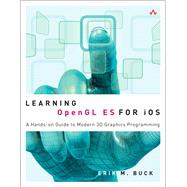
What is included with this book?
| Preface | p. x |
| Using Modern Mobile Graphics Hardware | p. 1 |
| What Is 3D Rendering? | p. 2 |
| Supplying the Graphics Processor with Data | p. 4 |
| The OpenGL ES Context | p. 9 |
| The Geometry of a 3D Scene | p. 9 |
| Summary | p. 17 |
| Making the Hardware Work for You | p. 19 |
| Drawing a Core Animation Layer with OpenGL ES | p. 19 |
| Combining Cocoa Touch with OpenGL ES | p. 22 |
| The OpenGLES_Ch2_l Example | p. 27 |
| Deep Dive: How Does GLKView Work? | p. 42 |
| Extrapolating from GLKit | p. 51 |
| Summary | p. 58 |
| Textures | p. 59 |
| What Is a Texture? | p. 59 |
| The OpenGLES_Ch3_l Example | p. 65 |
| Deep Dive: How Does GLKTextureLoader Work? | p. 69 |
| The 0penGLES_Ch3_3 Example | p. 76 |
| Opacity, Blending, and Multi-Texturing | p. 77 |
| Texture Compression | p. 84 |
| Summary | p. 85 |
| Shedding Some Light | p. 87 |
| Ambient, Diffuse, and Specular Light | p. 88 |
| Calculating How Much Light Hits Each Triangle | p. 90 |
| Using GLKit Lighting | p. 95 |
| The OpenGLES_Ch4_1 Example | p. 97 |
| Bake Lighting into Textures | p. 104 |
| Fragment Operations | p. 105 |
| Summary | p. 106 |
| Changing Your Point of View | p. 107 |
| The Depth Render Buffer | p. 107 |
| The OpenGLES_Ch5_1 and OpenGLES_Ch5_2 Examples | p. 109 |
| Deep Dive: Adding a Depth Buffer Without GLKKit | p. 115 |
| Transformations | p. 117 |
| Transformation Cookbook | p. 129 |
| Perspective and the Viewing Frustum | p. 130 |
| Summary | p. 132 |
| Animation | p. 133 |
| Motion Within a Scene: The OpenGLES_Ch6_l Example | p. 134 |
| Animating Vertex Data | p. 140 |
| Animating Colors and Lights: The OpenGLES_Ch6_3 Example | p. 148 |
| Animating Textures | p. 153 |
| Summary | p. 157 |
| Loading and Using Models | p. 159 |
| Modeling Tools and Formats | p. 160 |
| Reading modelplist Files | p. 165 |
| The 0penGLES_Ch7_1 Example | p. 168 |
| Advanced Models | p. 172 |
| Summary | p. 181 |
| Special Effects | p. 183 |
| Skybox | p. 183 |
| Deep Dive: How Does GLKSkyboxEffect Work? | p. 186 |
| Particles | p. 199 |
| Billboards | p. 206 |
| Summary | p. 216 |
| Optimization | p. 217 |
| Render as Little as Possible | p. 218 |
| Don't Guess: Profile | p. 232 |
| Minimize Buffer Copying | p. 234 |
| Minimize State Changes | p. 235 |
| Summary | p. 236 |
| Terrain and Picking | p. 237 |
| Terrain Implementation | p. 237 |
| Adding Models | p. 249 |
| OpenGL ES Camera | p. 253 |
| Picking | p. 258 |
| Optimizing | p. 267 |
| Summary | p. 274 |
| Math Cheat Sheet | p. 277 |
| Overview | p. 278 |
| Decoding a Matrix | p. 279 |
| Quaternions | p. 296 |
| Surviving Graphics Math | p. 297 |
| Summary | p. 301 |
| Putting It All Together | p. 303 |
| Overview | p. 304 |
| Everything All the Time | p. 306 |
| Device Motion | p. 323 |
| Summary | p. 325 |
| Index | p. 327 |
| Table of Contents provided by Ingram. All Rights Reserved. |
The New copy of this book will include any supplemental materials advertised. Please check the title of the book to determine if it should include any access cards, study guides, lab manuals, CDs, etc.
The Used, Rental and eBook copies of this book are not guaranteed to include any supplemental materials. Typically, only the book itself is included. This is true even if the title states it includes any access cards, study guides, lab manuals, CDs, etc.